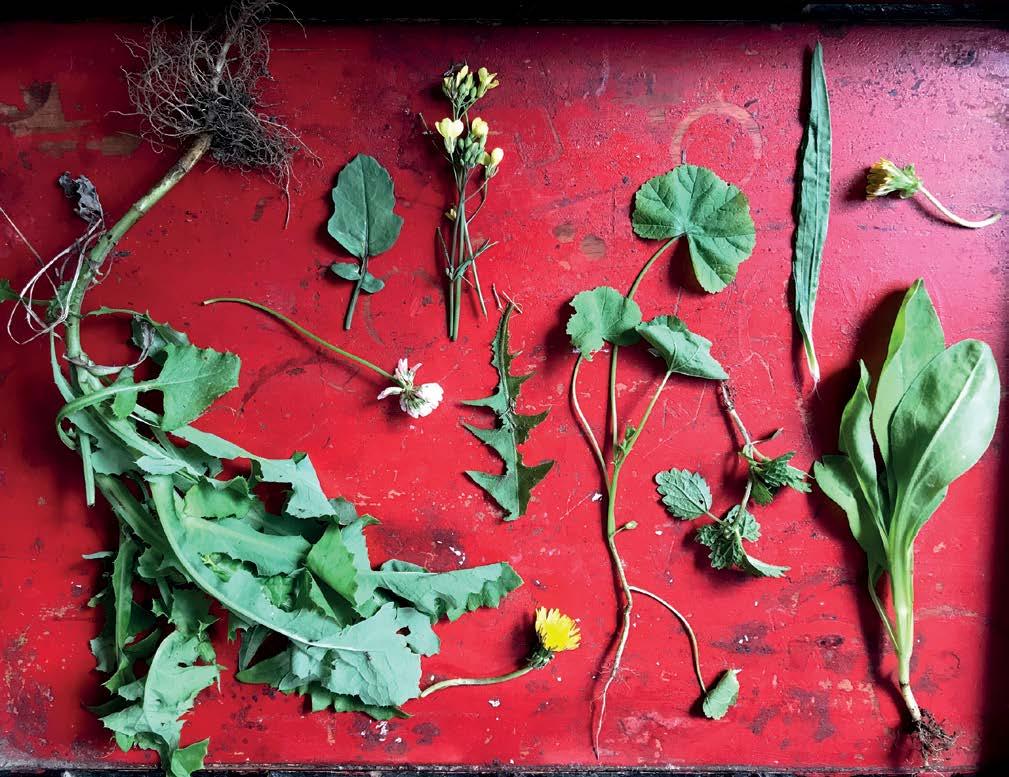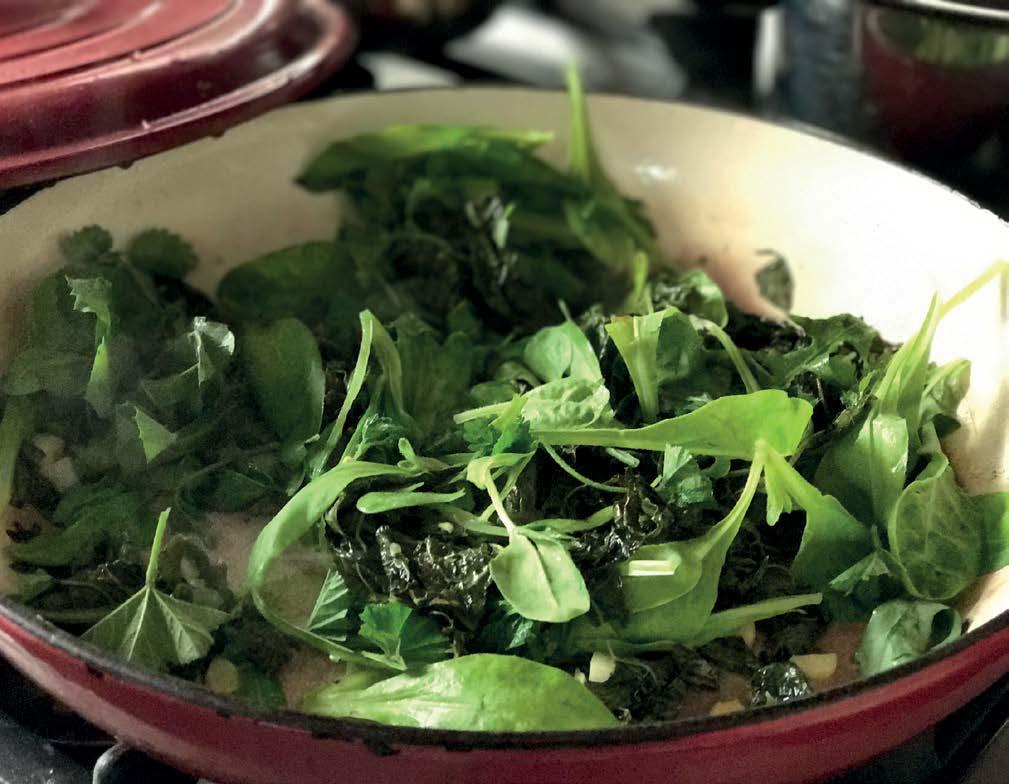
5 minute read
Gardener’s Revenge
from Junkies Issue 20
by junkies
For generations, people around the world have known how to identify, harvest and cook the wild food around them. This spanakopita is one of the many ways to feed your family and friends while getting to know some of the most nutritious and resilient plants around.
Words and Photography by Nicole Azzopardi
Advertisement
This variation of spanakopita was made with young calendula seedlings, a handful of mallow and a cup or two of fresh nettles. Dandelion leaves and flowers as well as clover flowers are also featured.
This dish lends itself to a good degree of flexibility depending on what is growing in your garden.
The young leaves of wild brassica and a juicy-looking sow thistle were also thrown into the mix. To this, I added a bunch of kale, but this can be substituted with silver beet or spinach depending on seasonality and availability.
Ingredients
Filling • 1 bunch chopped spinach, silver beet or kale • 4-6 handfuls of assorted edible weeds found in the garden* • 2 bunches flat-leaf parsley, finely chopped • 1 large yellow onion, finely chopped • 2 garlic cloves, minced • 2 Tbs olive oil • 2 eggs • 200g feta cheese, crumbled • 200g ricotta cheese • 1 generous handful of finely chopped fresh herbs such as dill, thyme, mint, oregano – or a mix of any herbs you have growing in your garden • sprinkling of sesame seeds
Pastry • 4-6 sheets of filo pastry** • 100g melted butter
Method
1. Preheat oven to 180°C. 2. Wash spinach, silver beet or kale thoroughly or drain well if frozen, squeezing out excess liquid by hand. 3. In a frying pan, gently cook onions and garlic until soft and aromatic in approximately 2Tbs of olive oil. Add all the greens and sauté until wilted. Allow to cool slightly. 4. In a mixing bowl, add the cooked greens and the remaining filling ingredients. Stir until thoroughly combined. 5. Unroll filo sheets and place them between two damp kitchen cloths to prevent drying out. 6. Brush bottom and sides of a baking dish with olive oil. 7. Line baking dish with two sheets of pastry, allowing them to fall over the sides of the dish if necessary. Brush with melted butter. 8. Spread filling over the bottom layer of the pastry. Top with two more sheets, and brush with butter. 9. Fold the excess pastry from the sides back into the dish; scrunch and crimp for effect if you wish. Brush folded sides well with olive oil or remainder of the melted butter. 10. Scatter sesame seeds across the top of your pie. 11. Bake for approximately 40 minutes to an hour, or until pastry is golden brown. Remove from the oven. 12. Cut your pie into squares and serve with a Greek salad and a bowl of warmed herby olives from your tree if you are lucky enough to have them!
Warning: Take the time to learn about your weeds. If in doubt, leave it out. Some edible weeds can be easily confused with more toxic plants.
* nettles, calendula, dandelion leaves, mallow and young sow thistle are particular favourites, but small amounts of finely chopped clover leaves and flowers, chickweed and plantain leaves will also work nicely in moderate amounts (plantain can taste a bit grassy in my opinion). Handy tip: If you enjoy the taste of your greens at this point and could eat them as you would a stir-fry, they are ready to be incorporated into your spanakopita.


Wild weed spanakopita can be made with edible plants available to you in your garden and surrounds. Be sure you source from an area that is unsprayed.

From nettles and dandelion greens to young calendula leaves and mallow, the tradition of knowing how to gather and cook edible weeds is shared by cultures all over the world.
Indigenous Australians have long known the virtues of wild medicinal plants.
The Tibetan Buddhist yogi, Milarepa, was found meditating in a cave, his skin having taken on a green colour from surviving on little else than nettle soup.
In Greece, down-to-earth dishes made with foraged weeds, or horta, literally meaning ‘greens’, have been a delicious staple for centuries, boiled and doused in zingy lemon juice and olive oil.
Modern-day Michelin-starred French restaurant, Le Cagnard, in southern France took things up a notch when it began offering it’s now acclaimed buttery ravioli, stuffed with either borage leaves or dandelion greens.
As for me, with half an acre of land out in a little country Victorian town, I’m keeping things pretty rustic, turning a rookie gardener’s mistake into a tasty autumn tradition.
It started when I let my companion calendula plant go to seed in my veggie patch. One plant quickly became two, two became four, four became eight. Next, a local delivery of sheep poo brought the nettles.
Chickweed then appeared, popping up as the weather cools, its little white star-shaped flowers and tender green leaves cascading over the soil like a green blanket.
Little by little, my whole patch became overrun by weeds.
Showing an elderly and experienced herbalist my predicament one crisp morning, she laughed out loud with glee.
“Ooh! They like it in there! Nicole, you can try pulling them out but eating your weeds is a gardener’s best revenge.”
So I got to work exploring how to cook with my calendula officinalis, or pot marigold as it’s known, because it has been used for centuries as a green for the soup pot and as a traditional way to soothe the stomach.
I made pasta with nettle pesto – a plant which boasts antihistamine properties; and steeped chickweed in apple cider vinegar and dried hibiscus flowers for rosy and tart salad dressings.
Finally, I took an old family favourite recipe my Grandma Claire often made for me as a child, and took my place beside her and a long line of Greek women who came before me, adding my edible weeds to this spanakopita to suit the forager in us all.







